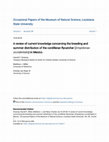Papers by Dr. Charles van Riper III

The Cordilleran Flycatcher (Empidonax occidentalis) is one of many North American birds whose dis... more The Cordilleran Flycatcher (Empidonax occidentalis) is one of many North American birds whose distribution crosses the US–Mexican border and for which little is presently known about summer distribution and breeding biology south of this border. In addition, the Cordilleran Flycatcher presents ornithologists with a number of challenging questions surrounding its taxonomy, migration, distribution, population structure, and species limits. In particular, there remains a good deal of uncertainty concerning the species-level relationships, seasonal movements, and the wintering and breeding distributions of both recognized subspecies of Cordilleran Flycatcher in Mexico. Using field observations, a thorough review of the literature, and the examination of several distributional databases, we compile current knowledge on Mexican populations during the summer months and emphasize directions for future research. We document the northern limit of confirmed breeding Cordilleran Flycatchers in ...
Ornitologia Neotropical, Oct 4, 2019

The Auk, 1984
The objectives of this study were to investigate the influence of nectar resources on: (1) territ... more The objectives of this study were to investigate the influence of nectar resources on: (1) territory establishment, (2) breeding success, and (3) postbreeding dispersal in Hemignathus virens on Mauna Kea, Hawaii. I observed color-banded individuals from 1971 to 1981 and manipulated food during the 1975 breeding season by placing supplementary nectar resources in an area where breeding had not occurred in the previous 4 yr. The results of this study demonstrated that H. virens is intrinsically tied to the nectar resources available within its breeding territory and that a minimum of 2,000 μl/day (1,400 cal) of nectar must be present before territory establishment will occur. This finding was further supported by the fact that no breeding occurred in the experimental area during the 6 yr after removal of the supplementary nectar. Breeding success of Hemignathus virens was influenced by different levels of nectar availability. The most successful breeding occurred at nectar levels of 2...
The Wilson Journal of Ornithology, 2015
The Southwestern Naturalist, 1993
Remote Sensing of Environment, 2012
Molecular Ecology Resources, 2009
Journal of Raptor Research, 2006
Journal of Biogeography, 2013
Journal of Animal Ecology, 2009

Ibis, 2008
SummaryThe behavioural ecology and breeding biology of the endangered Palila Psittirostra bailleu... more SummaryThe behavioural ecology and breeding biology of the endangered Palila Psittirostra bailleui was studied from 1971 to 1975. The most intensive breeding occurred from June to August, and coincided with peak production of mamane Sophora chrysophylla seeds, the bir?s major food source. The Palila was able to make adjustments in its breeding to compensate for yearly differentiation in the timing and abundance of this food supply.Sexual chasing and courtship feeding were the most frequently encountered pre‐nesting behaviours. Territory was a mate‐defended area, which later in the nesting sequence was confined to the nest site. A total of 26 nests was found; most were placed on larger branches of mamane trees. Nest construction occurred primarily in the morning hours and lasted up to 20 days. Both sexes took part in nest construction, albeit the male role was minimal. Unless the nest was placed in the terminal fork of a tree, it usually contained a large stick base.The modal clutch ...
The Condor, 1976
... When the hawk finished feeding and flew away (a period of about two min), the shrike flew to ... more ... When the hawk finished feeding and flew away (a period of about two min), the shrike flew to the vacated feeding perch and began to peck at the stump, where I subsequently found fresh blood. ... ADDITIONAL EXPLOITERS OF NECTAR LANNY H. FISK AND DAVID A. STEEN ...
The Condor, 1979
... Upper eleva-tional limits are still generally dictated by its habitat, the ohia (Metrosideros... more ... Upper eleva-tional limits are still generally dictated by its habitat, the ohia (Metrosideros collina) and ohia-koa (Acacia koa) forests on both Mauna Loa and Mauna Kea. We have, how-ever, regularly seen Omao in alpine and sub-alpine scrub habitats on Mauna Loa. ...

Uploads
Papers by Dr. Charles van Riper III